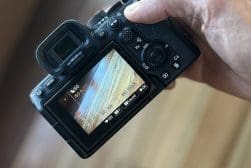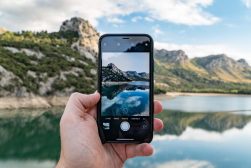Concert Photography in 2023: Tips, Settings, Ideas & Jobs
Photographing concerts and live music events is exciting, fun and challenging. Learn the key tips to succeeding... and surviving in the photo pit!
Learn | By Ana Mireles
If you’re wondering how to photograph a concert like a pro, this is the article for you.
I’ll give you the best concert photography tips so you can capture the perfect shot every time, whether from the audience or the photo pit.
I’ll also talk about the business side of shooting live events and music concerts.
I’ll talk about earnings, rights, photo passes and how to become a concert photographer and start earning money from your passion.
So, keep on reading!
Table of Contents
7 Concert Photography Tips for Great Results in 2023
1. Which are the best cameras for concert photography?
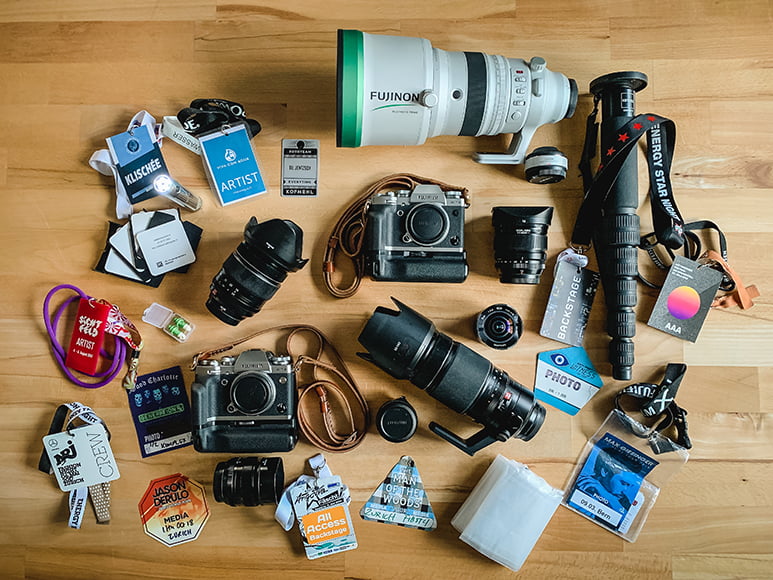
Camera Gear of event photographer Til Jentzsch on Shotkit
The right camera gear helps you to capture great concert photos.
You can use a mirrorless camera or a DSLR. There’s much debate over which is best to shoot concert photography. You can check out the difference more in-depth in this Shotkit guide.
Before you decide which one to buy, you should check out the specs on specific features that are key to photograph concerts.
You need your camera sensor to perform well in low-light conditions. In other words, you can raise the ISO without losing quality.
Another important feature is that it should be able to shoot and process images quickly. Last but not least, it should have an excellent autofocus system that’s fast and accurate in low light.
Here are some suggestions for the best cameras for live music photographers.
- Sony A9 II
- Sony A7R III
- Canon EOS 5D Mark IV
- Fujifilm X-T3
- Nikon Z6 II
2. What lens is best for concert photography?
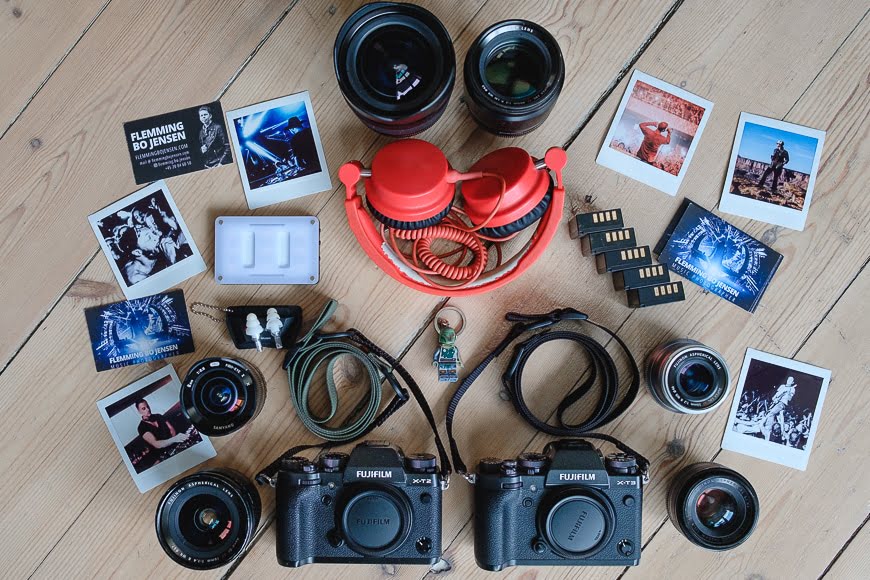
Camera gear of professional concert photographer Flemming Bo Jensen.
Having the right gear goes a long way toward capturing great photos. Some may argue that the lens is the most important part of the gear.
Fast lenses are very important because you’ll work in low light conditions. Some photographers prefer zoom lenses due to their versatility. Other photographers prefer prime lenses because they have wider apertures – perfect for a concert’s lighting conditions.
24mm
Wide-angle lenses work well in small venues. A 24mm focal length doesn’t distort the features too much and still allows you to capture crowd shots and the stage.
50mm
A 50mm lens is versatile and will work in many situations. It’s also an inexpensive, fast lens – you can find affordable solutions with an f/1.8 aperture.
24-70mm
Most live music photographers like this zoom range. It allows for capturing great shots from the photo pit and working in small venues.
It’s also easy to find in most brands with a constant maximum aperture of f/2.8.
70-200mm
If you’re not so close to the stage and want to capture close-ups of the band members, this is the zoom lens you need.
3. What are the best settings for concert photography?
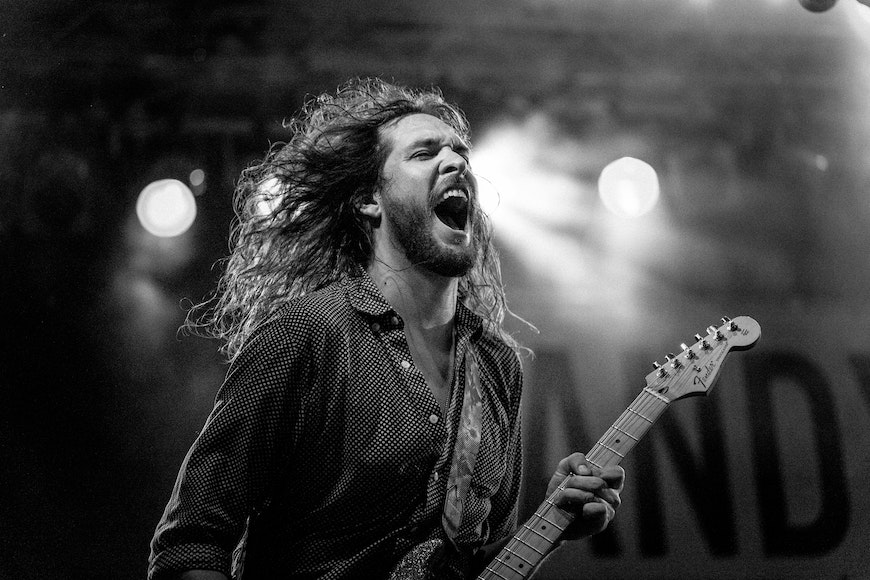
It’s one thing to have the equipment and another to know how to use it. It’s important that you use your camera in manual mode.
This way, you can adjust the shutter speeds to avoid blurred images. You’ll also understand how to compensate for this with the other camera settings.
I’ll tell you about the best settings for concert photography. However, each situation calls for specific adjustments. The best way to learn how to make a great shot is with practice.
In concert photography, your priority setting needs to be the shutter speed. This is because the band is constantly moving, and you need to be able to freeze motion.
One or two motion blur images with a creative purpose may be ok, but mainly, you want your subject sharp. This means that you need a shutter speed that’s at least 1/125. If it’s possible, make it faster.
You should adjust the rest of the camera settings based on the ideal shutter speed.
You’ll want to use a wide aperture since you’re using a faster shutter speed. You can start with the widest aperture of your lens and take a test shot.
This is because wider apertures create a narrow depth of field. So, take a few photos and make sure that your subjects are entirely in focus. Otherwise, close your aperture a f/stop or two.
If you’re shooting a daytime concert, you won’t have so many problems with the amount of light. In that case, you can find the sweet spot of your lens and use that one.
Otherwise, you can set the camera to aperture priority mode. Just make sure that the shutter speed isn’t too slow and that it’s able to freeze the subject.
When you shoot a concert inside or at night, you’ll most likely need to use a high ISO to compensate for the fast shutter speed. Usually, an ISO between 1600 and 3200 is enough.
However, if this isn’t enough, you should raise the ISO instead of moving any of the other camera settings.
Instead, outdoor concerts during the day won’t give you this problem. You can use a lower ISO depending on the light conditions and the other camera settings.
The stage lights constantly change during a concert – often with color gels. Your safest bet is to set the AWB (auto white balance).
Turn on the continuous autofocus with the tracking subject if your camera has it. This way, your camera can keep up with the constant movements of the band.
4. Do you use flash for concert photography?
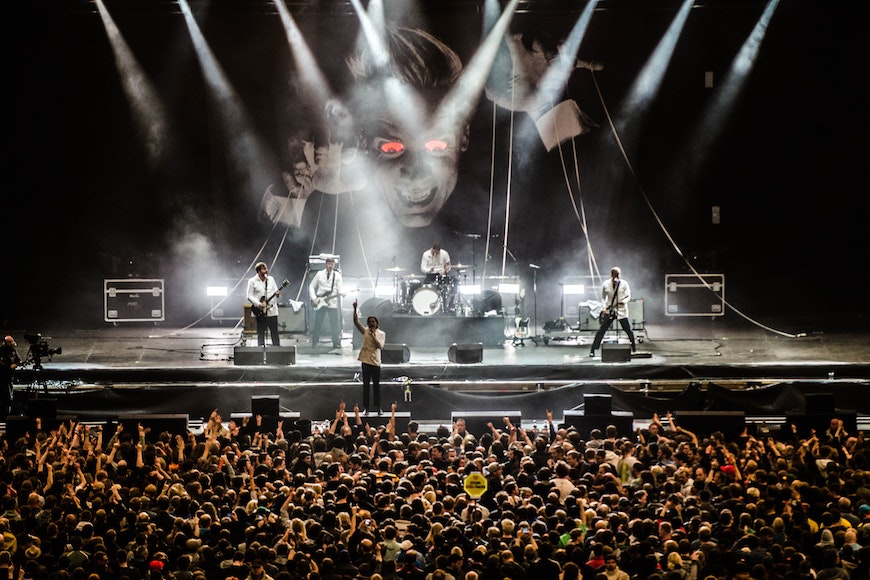
Flash photography doesn’t pair well with a live music event.
As a general rule, using flash in concert photography is not allowed. It may be banned by the performers or the venue. So, you should always check with both of them if you plan to use one.
However, most concert photographers know how to adapt to the stage lighting by adjusting the camera settings. This is because the flash is too disruptive. So, out of respect for the band, it’s better to avoid it.
5. What film is good for concert photography?
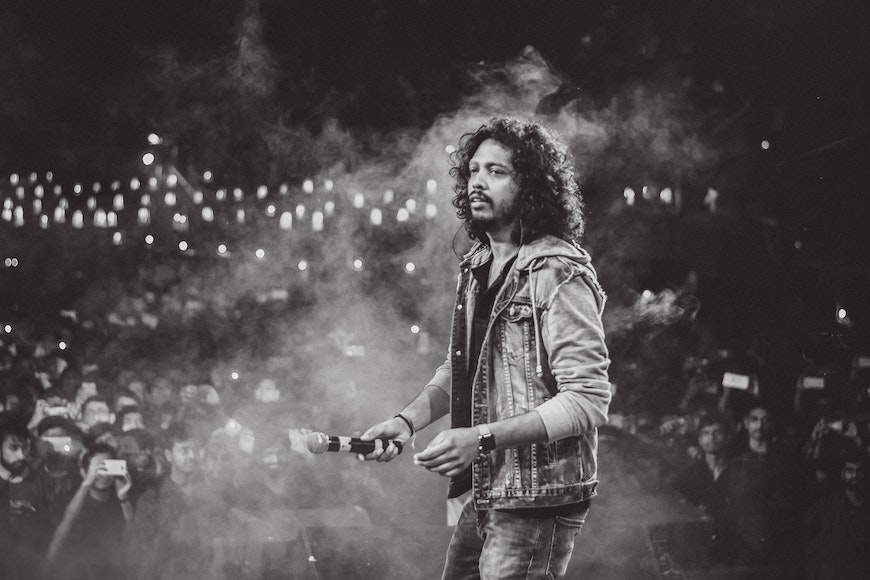
It’s not very common to use film for concert photographs. However, pro concert photographer Matthias Hombauer does enjoy shooting 120mm film with his Hasselblad 503 CX. He also uses instant film photographs for behind-the-scenes pictures.
It’s also possible to use a 35mm one; make sure you get the fastest one. A high ISO is key to photographing in low light.
The film should also have a wide exposure latitude. This combination isn’t easy to find, but black-and-white films work tend to work better. The Ilford HP5 Plus and the Kodak Tri X are known for performing well in live music photography.
6. How do you get a photo pass?
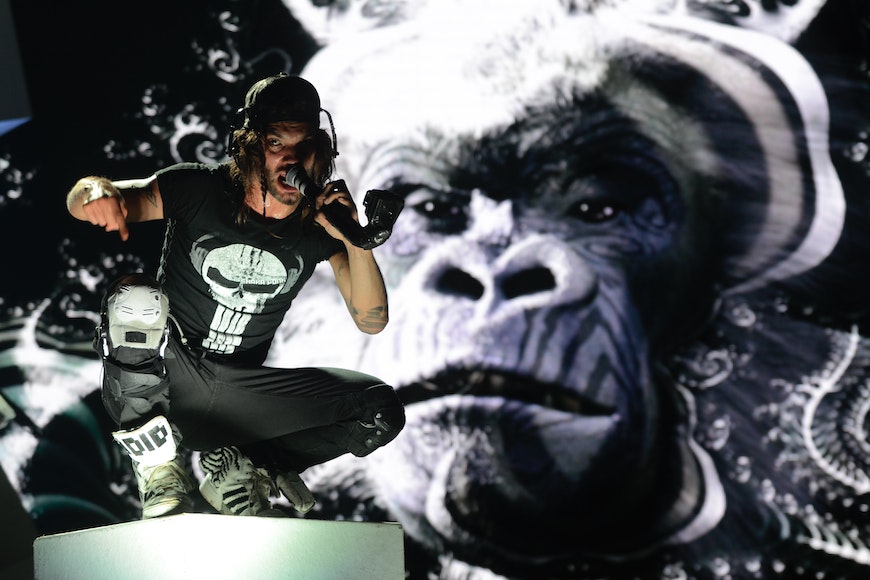
The most challenging part about building a solid concert portfolio is getting access. Working at smaller venues and with emerging talents is an excellent way to practice and develop a portfolio.
However, you’ll want to get into the big leagues at some point. Unfortunately, you can’t simply show up and start shooting shows.
First of all, purchasing your own tickets won’t get you the best location or perspectives to get good shots. Also, you won’t have clearance to bring your camera or use the photographs.
What you need is to get a photo pass. Photo passes can be badges, wrist bracelets or any other form of visual identification. This way, security guards will know that you’re allowed there.
You’ll also get free entry to the photo pit with a photo pass. This is a designated area for photographers in front of the stage.
Photo passes aren’t easy to come by. To get a photo pass, you should work for a known publication – especially for the most coveted concerts.
Remember that lesser-known bands benefit from media exposure. However, more renowned ones don’t need publicity. Instead, every publication may be a liability.
In short, photo passes are granted to photographers working for a publication or a news/photo agency and those hired by the venue or the artist.
7. Concert photography post-production
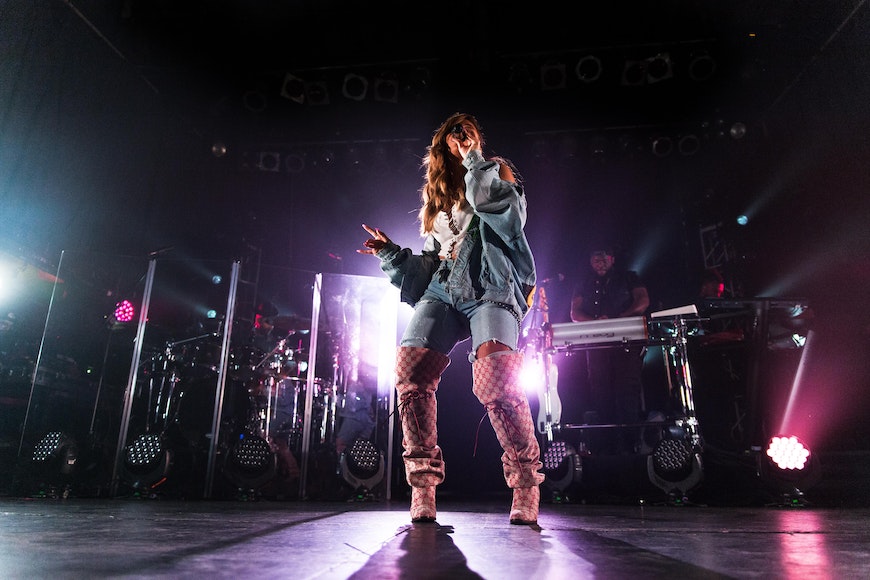
The white balance is one of the first things you need to adjust in post-processing. During the concert, the light often changes colours. So, you might need to do some WB corrections to start your editing.
As mentioned, most concert photographs are taken in low light and flash photography isn’t allowed. So, you’ll probably need to adjust the exposure as well.
Hopefully, you shot your photos in raw format. This will give you more leeway in your editing. You’ll be able to recover more details from the shadows.
Since you need more light coming into the camera, you probably used an ISO that’s high enough to cause noise in the image.
You can use the noise reduction tool to improve the image quality. Make sure you’re not losing too much sharpness by doing this. You have to find the right balance.
How Do You Become a Concert Photographer?
It’s not easy to break into concert photography. Unless you have a big connection, you’ll need to work your way up.
Start by photographing musicians, bands, and venues you can access easily. You can go to a local bar with live music – for example.
You can also visit the conservatory or music schools and offer to photograph concerts for them. All of these is good practice.
While you’re there, talk to some of the students and see if they’re interested in having their photos taken. Many concert photographers start by doing music photography.
Once you get enough experience and your concert photos are consistently good, you can build a portfolio website. This will help you to get your work out there.
Networking is critical in live music photography. So, use every chance you get to connect with people in the music business.
One way to grow your network is by working with students or emerging bands and growing with them. They will use your photos for their social media or provide them if they get featured in a magazine.
As a result, the people in those magazines or social media managers will get to know you. This way, you might get some assigned jobs from them.
Once a publication hires you, you can ask for a photo pass and hopefully get access to the photo pit. The type of photos you can get from there will enrich your portfolio. It will give you more credibility.
Also, getting a photo pass means that the band’s agent and the venue’s staff know your name. Also, working behind the scenes and in the pit, you’ll be in contact with other photographers. This is another opportunity to network.
FAQ’s About Concert & Music Photography
Do concert photographers make money?
If you want to know if concert photography pays well, you might have difficulty finding a straight answer. A live music photographer may be able to live just from that, while others need to complement their income with other gigs.
At an entry-level, a music photographer in the US charges $20-$25 per hour on average. You may also charge a daily fee if you work at a festival. In this case, the range goes from $150 to $300 daily.
You can license your images to music publications if you’re not paid for hire. This may pay around $100 or $200. It depends on the band, the magazine, and the rights you offer (for example, if they want exclusive use of your photos).
A concert photographer is usually a music photographer too. This means that you can work with bands and musicians in the studio, not just when they’re performing.
Most of them will need portrait photos for their website or to be featured in magazines and blogs. You can also work with them on their album covers. This isn’t always a portrait of the band – it may be more conceptual work.
Another way to get concert photography gigs is by working directly with publications. So, it’s not the band that hires you but the magazine.
This type of job is difficult to price because it depends on how big is the magazine’s budget. It also depends if you’re doing an editorial or a cover shoot. So, the price can range from $200 to $3000.
Is concert photography hard?
Concert photography is not the easiest one to master. However, you can do it if you stick to it and shoot concerts regularly.
One of the most challenging things is the low light available in live concerts. If you use slower shutter speeds, you can get blurry images. So, you must use a fast shutter speed.
This means that you should raise the ISO and open the aperture – a fast lens will help you out.
Once you nail the technical aspects, you can keep working on your style and composition. Try to capture the bands from different angles. This isn’t always easy when you have limited space.
Generally speaking, the technical part isn’t the hardest. Landing the gigs is the toughest part of this job.
To overcome this, start with small venues where you don’t need photo passes. You’ll eventually land larger events in other venues as you improve and network.
What are the responsibilities of a concert photographer?
Your responsibility as a concert photographer is to capture images of stage performers in action.
These photographs are almost immediately used in news, music publications, and social media channels. In the long run, they’re also used in merchandising and to promote future tours.
Can you sell photos you took at a concert?
Generally speaking, you can’t sell your photos for commercial use without written consent from the band or the legal representative. You might need permission from the venue as well as it is private property.
If a publication hired you to take the photos and got you a photo pass, you probably can’t sell them to a third party. For this, you need to negotiate the rights of your images on your contract.
Photographs used for journalism are usually protected by the freedom of speech or the right to information law. However, this may be different in each country.
This is because there are laws that protect the person’s privacy and the right to decide how they wish to be represented. So, double-check with a legal advisor before selling your photos, even for editorial use.





